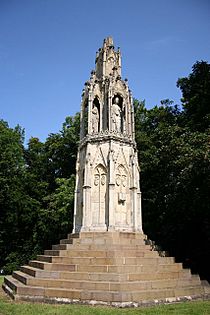Eleanor Cross, Sledmere facts for kids
A replica Eleanor Cross was built in Sledmere, East Riding of Yorkshire, between 1896 and 1898. This tall stone structure was created by the Sykes family of Sledmere. After the First World War, special engraved monumental brasses were added. This turned the cross into a war memorial.
Contents
What is the Sledmere Cross?
The Sledmere Cross is a very tall stone monument. It stands about 60 ft (18 m) high. It was ordered by Sir Tatton Sykes, 5th Baronet (1826–1913). His rich family had moved to Sledmere in the early 1700s. They lived at Sledmere House.
Building a Special Cross

The cross was designed by an architect named Temple Lushington Moore. He based it on a much older cross from the 1200s, the Eleanor cross at Hardingstone, Northamptonshire. It was built using limestone by stonemasons called Thompsons of Peterborough. John Barker of Kennington added beautiful carvings.
The cross has several levels. It stands on a base with eight steps. The bottom part has panels with carvings of shields. These shields show symbols of England, nearby towns like Kingston upon Hull, and families connected to the Sykes family. There are also carvings of flowers and animals.
The next level has four open spaces, each holding a statue of Queen Eleanor. These statues were once painted. The top part of the cross has four more statues, each showing the Virgin Mary. A stone point and a bronze crucifix sit at the very top.
Remembering Heroes: The War Memorial
In 1918, the cross was changed to be a war memorial. This was done by Lt Col Sir Mark Sykes, 6th Baronet. He wanted to remember officers from the 5th Battalion Yorkshire Regiment who had died. He also wanted to honor soldiers from the Sledmere area and two other soldiers he knew.
Sir Mark Sykes added a bronze crucifix. He also added 22 engraved monumental brasses. These were made by Gawthorp and Sons of London. Some brasses show soldiers in their modern uniforms. Others show them like knights from the 1300s. These brasses were put on the cross over time, starting in 1918. Each one had its own special unveiling ceremony.
Sir Mark Sykes went to the Paris Peace Conference in 1919. He was an expert on the Middle East. Sadly, he caught Spanish flu and died in Paris in February 1919. The people of Sledmere decided to add one more figure to the cross. This figure was of Sir Mark Sykes himself. It shows him as a knight with a shield.
The figure of Sykes was revealed on April 3, 1921. This was done at the same time as the last of the other brasses. Soldiers from the 5th Battalion, Green Howards, were there. Many veterans from the 5th Battalion Yorkshire Regiment also attended.
The cross has an inscription that says: "THE NAMES INSCRIBED / ON THIS MEMORIAL ARE THOSE / OF OFFICERS AND MEN / OF THE 5 YORKSHIRE REGT / WHO GAVE THEIR LIVES / FOR THEIR KING AND / COUNTRY & THE LIBERTIES / OF MANKIND IN THE YEARS / OF THE GREAT WAR/LET YORKSHIRE MEN / CHERISH THE MEMORIAL/OF THIS HONOURABLE / COMPANY OF CITIZENS / WHO LEFT THEIR PEACE / (...) TO / UPHOLD JUSTICE PROTECT / THE WEAK AND DEFEND / THE RIGHT". It then lists 24 names.
The Sledmere Cross is a very important historical site. It was first listed as a Grade II building in 1966. In 2016, its importance was recognized even more when it was upgraded to Grade I.
Other Nearby Memorials
There are other important memorials close by. The Wagoners' Memorial is also listed as Grade I. It was designed by Sir Mark Sykes. A few miles away in Cowlam, there is a tall stone memorial for Sir Tatton Sykes, 4th Baronet.
Images for kids
-
Sir Tatton Sykes's monument in Cowlam
See also
 In Spanish: Eleanor Cross (Sledmere) para niños
In Spanish: Eleanor Cross (Sledmere) para niños



